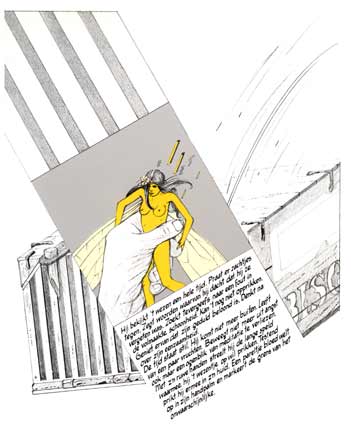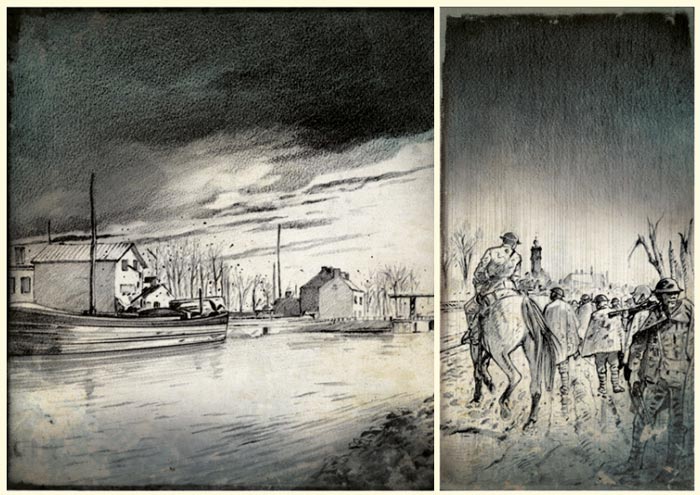'L'Evasion d'Ivan Casablanca'.
Claude Renard (1946-2019) was a Belgian comic artist, teacher and designer. With only a limited comics oeuvre, containing the series 'Ivan Casablanca' (1984-1986) and his collaborations with François Schuiten, he has left a more lasting mark with his work as a teacher. Through his famous Atelier R at the Institut Saint-Luc in Brussels, he influenced an entire generation of new artists, which innovated the Franco-Belgian comics landscape during the 1980s and 1990s.
Early life and career
Claude Renard was born in 1946 in Boussu, a town near Mons, not far from the French border. Several sources credits Renard as the artist of several short stories in the educational series 'Les Belles Histoires de l'Oncle Paul' in Spirou magazine between 1963 and 1966, but the "Renard" in question was in fact an early pen name for Gill van Dessel (Mister Kit). Claude Renard received his artistic education at the Institut Saint-Luc in Brussels, where he studied painting, while also taking courses in comics art from Eddy Paape. In fact, he was Paape's first student in this new discipline. After fulfilling his military service, Renard worked for the magazine Le Journal de Bruxelles from 1972 to 1975, headed by Jean-Luc Vernal, the future editor-in-chief of Tintin magazine. Renard provided the magazine with comics, illustrations, caricatures, photo reports and lay-outs.
Cover illustrations for Le 9ème Rêve'.
Saint-Luc
By 1975, Renard was asked to supervise the course in comics art at Saint-Luc. In his first year, he assisted Eddy Paape, but when the maestro left in 1976, Renard became his successor. During a period of eight years, he trained a new generation of artists in the famous Atelier R. Whereas Paape was a more traditional comic artist, Renard's tenure began in a period when comics were gradually accepted as an art form. Magazines like Métal Hurlant, L'Écho des Savanes, Hara-Kiri and Pilote had provided a platform for more adult-oriented and experimental comics. The modernist Renard encouraged his students to experiment and develop their own, personal styles. To showcase the work of his pupils, Renard initiated the annual anthology Le 9ème Rêve, of which the first volume appeared in early 1978. It was for the first time that a comic publication appeared with a government grant, thanks to Walloon Minister of Culture Jean-Maurice Dehousse. André Franquin provided the foreword. Four more volumes of Le 9ème Rêve followed until 1984.
Many of the artists trained by Renard have become staples in the Franco-Belgian comic industry. Some have turned to more conventional comics art, others remained on the experimental path Renard paved for them. To name but a few of Renard's students: Andréas, Philippe Berthet, Frédéric Bézian, Antonio Cossu, Chantal de Spiegeleer, Michel Duveaux, Philippe Foerster, Philippe Francq, Gérard Goffaux, Alain Goffin, Marc Hernu, André Moons, André Osi, François Schuiten, Séraphine, Benoît Sokal and Yves Swolfs. Schuiten became a teacher at the Atelier as well after his own graduation. When Renard left around 1983, the atelier was headed by Pierre Pourbert and Mark Sevrin.
'Aux Médianes de Cymbiola' by Schuiten & Renard.
Comics career
Claude Renard's own comics career was rather short-lived. His first excursions were in collaboration with his former pupil François Schuiten, with whom he wrote and drew the two stories 'Aux Médianes de Cymbolia' (1979) and 'Le Rail' (1981). Both stories were of an experimental nature, and dealt with fantasy subjects like ancient civilizations. After their initial publication in Métal Hurlant, Les Humanoïdes Associés collected them in two books which form the 'Métamorphoses' series. As an artist, Renard remained affiliated with both Métal Hurlant and Métal Aventure until 1986. Besides a couple of short stories in collaboration with scriptwriter Jean-Luc Fromental, he wrote and drew the serial 'Les Évasions d'Ivan Casablanca' (1983). The main character returned in a second story, called 'Le Rendez-vous d'Angkor' (1985), for which Fromental provided the script. The 'Ivan Casablanca' stories were a mix of science fiction, historical adventure and fantasy, and were collected in two books.
'Les Elfes de Pomariolus'.
Other artistic work
In the early 1980s, Renard and François Schuiten had already done art direction and costume design for the movie 'The Perils of Gwendoline in the Land of the Yik Yak' (1984) by director Just Jaeckin. An erotic art book with some of their preliminary designs was published under the title 'Les Machinistes' (1984) by Les Humanoïdes Associés. By 1986, Renard largely left the comic industry, and focused on his other artistic projects. He regularly worked with the writer Yves Vasseur, with whom he made the experimental 'Les Elfes de Pomariolus' (Schlirf-Book, 1984), as well as an illustrated art book about 18th-century French bandit Antoine-Joseph Moneuse (1987). Renard also provided the illustrations for a trail in the Parc Naturel des Hauts-Pays, where Moneuse had his hideout. Renard and Vasseur teamed up again for historical books like 'Galilée. Journal d’un Hérétique' (2001) and 'Maroc, Lettres à Matisse Sous le Protectorat Français' (2003). Renard additionally illustrated the novel 'Un Goût de biscuit au gingembre' (2006) by Xavier Hanotte, and worked extensively as a designer of sets, costumes and props for the Belgian theater director Franco Dragone. Dragone is known from his own large scale theater shows, but also from his work with the Cirque du Soleil, Disneyland Paris and Céline Dion.
Return to comics
Claude Renard returned to the comics medium with the historical art book/graphic novel '1914-1918, Les Anges de Mons' (2014) from a script by Xavier Hanotte. The graphic novel was published at the occasion of the 100th anniversary of the Battle of Mons, the first military encounter between the British and the Prussians during World War I. The coloring was provided by Romain Renard, the artist's son, who is also active as a storyboard artist and comic artist.
The veteran artist passed away in the morning of 17 February 2019, at the age of 72. His legacy lives on in the many comic artists he has helped in the early stages of their career. Many of them fondly remember the companionship in the Atelier R, where Renard gave them full creative freedom. Benoît Sokal gave his former teacher a prominent role in his 2005 'Canardo' album 'L'Affaire Belge', which offers a satirical look at the Belgian comic industry.
From: '1914-1918, Les Anges de Mons'.








